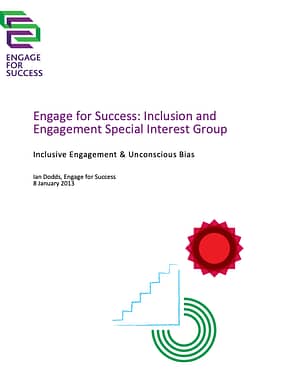Inclusion and Engagement was the topic of a Thought and Action Group led by Ian Dodds, Director of Ian Dodds Consulting. The purpose of this Group was to find out how organisations can address the vital question of how to build inclusive cultures that engage every member of the workforce fully, whatever their diversity.
Click below to view and/or download the Inclusive Engagement & Unconscious Bias TAG Report.
The following is an introduction and summary of steps to generate inclusive engagement and address unconscious bias.
BUSINESS BENEFITS OF ENGAGEMENT
ENGAGEMENT ENHANCES PERFORMANCE
Firms with engagement scores in the top quartile averaged 12 per cent higher customer advocacy, 18 per cent higher productivity and 12 per cent higher profitability;
The EPS (Earnings Per Share) growth rate of organisations with engagement scores in the top quartile was 2.6 times that of organisations with below-average engagement scores (Gallup 2006)
ENGAGEMENT INCREASES INNOVATION
Higher levels of engagement are strongly related to higher levels of innovation. Fifty-nine per cent of engaged employees say that their job brings out their most creative ideas against only three per cent of disengaged employees (Gallup 2007)
Yet there is much evidence that under-represented groups in organisations often experience lower levels of engagement. For example, in North America and Northern Europe government, industry and commerce, education, health, etc., have historically evolved under the direction of white, heterosexual, educated men. This has often resulted in the cultures within them developing in line with the values and characteristic practices of this group. Hence, they tend to possess white, masculine cultures. This results in individuals who are not white and male experiencing unconscious bias, which can limit their engagement, performance and their career progression. It not only manifests itself in the workplace, but also at customer, client and service user interfaces, resulting in lost revenue and business development opportunities.
This paper (download below right) examines some of the existing research on this topic. It will then demonstrate the continuing existence of exclusion and unconscious bias from the observations of women and minority ethnic focus group participants’ experiences in their organisations. Finally, it offers methodologies for building inclusive engaging cultures to gain significant business benefits.
SUMMARY OF sTEPS THAT NEED TO BE TAKEN TO GENERATE INCLUSIVE ENGAGEMENT AND ADDRESS UNCONSCIOUS BIAS
- It is critical that the most senior management reach both an intellectual and emotional understanding of the impact of exclusion and unconscious bias as it plays out for different diversity strands. This builds their determination to drive the necessary changes.
- It is vital to invest in long-term strategic effort which will transform the prevailing white, masculine culture into one that is more inclusive of all types of diversity.
- The most senior management must regularly offer compelling messages about the business importance of having inclusive engagement in the workplace and marketplace.
- They must identify the behaviours that will drive inclusivity in their organisations and set a consistent example in them.
- The workforce needs not only to understand how the organisation will be more successful if its people are more engaged through thinking and behaving inclusively; but also to be engaged in helping deliver the necessary changes, for example through project teams and task forces.
- Organisations need to invest in training programmes to raise awareness of unconscious bias and the behaviours needed to engage inclusively with colleagues and customers, clients or service-users. This includes training in interactive behavioural effectiveness so that employees become better able to explore differing opinions, ideas and points of view and build on others’ suggestions to generate innovative and successful solutions to complex business problems.
- Training alone is insufficient to drive the necessary cultural shift. It needs to be reinforced by the leadership message and example and follow-up activities, including the use of internal change agents.
- Progress needs to be measured in terms of both the ‘softer’ change in inclusive engagement, such as through measuring engagement indices for different diversity strands, and in terms of ‘harder’ business-related outcomes, for example retention of high potential under-represented employees, new business gains, customer satisfaction indices.





